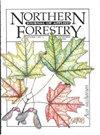Oak forest composition on contrasting soil types at the Mohonk Preserve, eastern New York.
引用次数: 5
Abstract
This research investigated overstory and understory forest composition for 10 sites derived from either shale or sandstone conglomerate parent material on the Shawangunk Ridge in eastern New York. Overstory composition in both soil types was dominated by red oak (Quercus rubra) and chestnut oak (Quercus montana), but the overstory on shale sites was more diverse (14 tree species) and had less oak than sandstone sites (with only 6 tree species). A total of 17 species were recorded as regeneration on shale sites, where seedlings averaged 21,466/ha and saplings averaged 1,833/ha. Dominant seedling on shale sites were chestnut oak (7,100/ha) and red oak (3,583/ha); chestnut oak had significantly more seedlings on shale versus sandstone sites. Saplings on shale sites were predominantly Hamamelis virginiana and Acer pensylvanicum. On sandstone sites, seedlings averaged 6,425/ha (including 2,075 oaks and 2,250 red maple per ha). Sapling numbers for all species were low (1,400/ha) and were mostly red maple. These forests are unique because of the relatively high density of oak seedlings on certain sites and low density of red maple across all sites. This variation in regeneration as well as management strategies to promote additional oak regeneration and canopy recruitment are discussed for these and similar forests.纽约东部莫洪克保护区对比土壤类型的橡树林组成。
本研究调查了纽约东部沙旺冈山脊上10个由页岩或砂岩砾岩母质组成的地点的林下植被组成。两种土壤类型的植被组成均以红栎树(Quercus rubra)和栗树(Quercus montana)为主,但页岩样地的植被组成更多样化(14种树种),栎少于砂岩样地(6种树种)。在页岩样地共记录到17种再生植物,幼苗平均21466株/ha,幼树平均1833株/ha。页岩样地优势苗木为板栗栎(7100株/ha)和红栎(3583株/ha);板栗栎在页岩上比在砂岩上有更多的幼苗。页岩样地的幼树以金锤李(Hamamelis virginia)和宾夕法尼亚槭(Acer pennsylvania)为主。在砂岩场地,平均每公顷6425棵树苗(包括每公顷2075棵橡树和2250棵红枫)。各树种树苗数量均较低(1400株/公顷),以红枫为主。这些森林是独特的,因为某些地点的橡树幼苗密度相对较高,而所有地点的红枫密度较低。本文讨论了这些森林和类似森林在再生方面的变化,以及促进栎树再生和冠层补充的管理策略。
本文章由计算机程序翻译,如有差异,请以英文原文为准。
求助全文
约1分钟内获得全文
求助全文

 求助内容:
求助内容: 应助结果提醒方式:
应助结果提醒方式:


